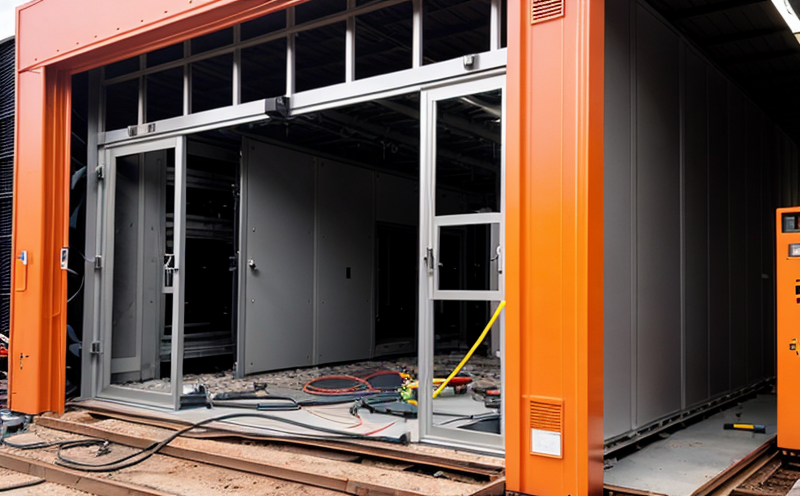ASTM D3333 Thermal Testing of Alkaline Manganese Dioxide Batteries
The ASTM D3333 thermal testing protocol is a critical procedure for assessing the safety and reliability of alkaline manganese dioxide batteries. This test evaluates how these batteries perform under various temperature conditions, ensuring they meet stringent safety standards before deployment in real-world applications.
Alkaline manganese dioxide batteries are widely used across numerous industries due to their high energy density and long shelf life. However, their ability to safely withstand extreme temperatures is crucial for preventing potential hazards such as overheating or thermal runaway, which could lead to fire or explosion risks.
The ASTM D3333 test involves subjecting the batteries to controlled temperature cycles designed to mimic real-world environmental conditions they might encounter. This includes exposure to high temperatures (up to 100°C) and low temperatures (-40°C). The objective is to observe any changes in performance or structural integrity that could indicate a potential safety issue.
During the testing process, it's essential to follow precise procedures to ensure accurate results. Specimen preparation typically involves selecting representative samples from each batch of batteries being tested. These specimens are then placed into an environmental chamber where they undergo defined temperature cycles according to ASTM D3333 specifications.
The testing apparatus used for this procedure includes specialized ovens capable of maintaining stable temperatures across wide ranges and precise control systems to monitor sample conditions accurately. The testing protocol specifies exact durations and intervals for exposing the batteries to different temperatures, allowing researchers to observe potential failures or anomalies systematically.
Acceptance criteria are based on visual inspections after each temperature cycle, checking for signs of damage such as cracks, bulges, or leaks that might compromise battery integrity. Additionally, performance metrics like internal resistance and capacity retention rates are measured post-test to assess overall battery health.
- Quality and Reliability Assurance: By adhering strictly to ASTM D3333 guidelines, manufacturers can ensure consistent quality across all units produced. This reduces the risk of defective products reaching consumers or being used in critical applications where safety is paramount.
- Environmental and Sustainability Contributions: Ensuring proper thermal management through rigorous testing helps prevent accidental fires or explosions caused by overheating. Such incidents can have severe environmental impacts, including pollution and resource depletion. By mitigating these risks early on during production stages, companies contribute positively to sustainability goals.
Why It Matters
The importance of ASTM D3333 thermal testing cannot be overstated when considering the diverse range of applications for alkaline manganese dioxide batteries. These include portable electronics, flashlights, toys, and other consumer goods where safety is a top priority.
For instance, in medical devices or emergency lighting systems, any failure due to overheating could have dire consequences. The test helps identify potential weaknesses early on, enabling manufacturers to address them proactively rather than reacting after incidents occur. This proactive approach not only enhances product reliability but also fosters trust among consumers who rely heavily on these products for daily use.
Furthermore, compliance with ASTM D3333 standards demonstrates a commitment to international safety regulations set forth by bodies like the International Organization for Standardization (ISO). Adhering to such protocols positions companies favorably in competitive markets where stringent quality controls are increasingly demanded by both buyers and regulators alike.
By incorporating rigorous thermal testing into their manufacturing processes, businesses can enhance brand reputation while simultaneously safeguarding end-users from avoidable risks. This contributes significantly towards building long-term customer relationships based on trustworthiness and reliability.
Quality and Reliability Assurance
- Ensures Consistent Quality: Adhering strictly to ASTM D3333 guidelines helps manufacturers maintain consistent quality across all units produced. This ensures that each battery meets the same high standards, reducing the risk of defective products reaching consumers or being used in critical applications.
- Identifies Potential Weaknesses: By conducting thorough thermal tests according to ASTM D3333 specifications, manufacturers can identify potential weaknesses early on. Addressing these issues proactively rather than reacting after incidents occur enhances product reliability and fosters trust among consumers who rely heavily on these products for daily use.
Environmental and Sustainability Contributions
- Mitigates Accidental Fires or Explosions: Ensuring proper thermal management through rigorous testing helps prevent accidental fires or explosions caused by overheating. These incidents can have severe environmental impacts, including pollution and resource depletion.
- Fosters Proactive Risk Management: By incorporating ASTM D3333 into their manufacturing processes, businesses proactively manage potential risks associated with thermal management issues. This contributes positively to sustainability goals by minimizing adverse effects on the environment while enhancing overall product reliability.





